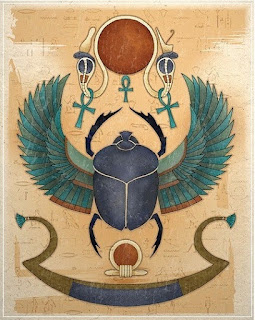Egyptian Art
Egyptian Art
Ancient Egyptian art is the painting, sculpture, architecture and other arts produced by the civilization of ancient Egypt in the lower Nile Valley from about 3000 BC to 30 AD. Ancient Egyptian art reached a high level in painting and sculpture, and was both highly stylized and symbolic. It was famously conservative, and Egyptian styles changed remarkably little over more than three thousand years. Much of the surviving art comes from tombs and monuments and thus there is an emphasis on life after death and the preservation of knowledge of the past.
Egyptian Treasure Trove
Egyptian icons have been popular for over five thousand years! Explore our Egyptian treasure troves for historic statues of ancient Egyptian deities and evoke the rich mystery of ancient Egypt with our exclusive decor hand-painted in a historic Egyptian palette.
≪You can buy online from Amazon≫
Appreciating & understanding ancient Egyptian art
Ancient Egyptian art must be viewed from the standpoint of the ancient Egyptians to understand it. The somewhat static, usually formal, strangely abstract, and often blocky nature of much Egyptian imagery has, at times, led to unfavorable comparisons with later, and much more ‘naturalistic,’ Greek or Renaissance art. However, the art of the Egyptians served a vastly different purpose than that of these later cultures.
Homeometric regularity, keen observation and exact representation of actual life and nature, and strict conformity to a set of rules regarding representation of three dimensional forms dominated the character and style of the art of ancient Egypt. Completeness and exactness were preferred to prettiness and cosmetic representation.
Pharaonic Art decor,
Because of the highly religious nature of Ancient Egyptian civilization, many of the great works of Ancient Egypt depict gods, goddesses, and Pharaohs, who were also considered divine. Ancient Egyptian art is characterized by the idea of order. Clear and simple lines combined with simple shapes and flat areas of color helped to create a sense of order and balance in the art of ancient Egypt.
Ancient Egyptian artists used vertical and horizontal reference lines in order to maintain the correct proportions in their work. Political and religious, as well as artistic order, was also maintained in Egyptian art. In order to clearly define the social hierarchy of a situation, figures were drawn to sizes based not on their distance from the painter's point of view but on relative importance. For instance, the Pharaoh would be drawn as the largest figure in a painting no matter where he was situated, and a greater God would be drawn larger than a lesser god.
Homeometric regularity, keen observation and exact representation of actual life and nature, and strict conformity to a set of rules regarding representation of three dimensional forms dominated the character and style of the art of ancient Egypt. Completeness and exactness were preferred to prettiness and cosmetic representation.
Pharaonic Art decor,
Egyptian decorations, Egyptian wall art
Ideas about Egyptian decorations on Amazon.Because of the highly religious nature of Ancient Egyptian civilization, many of the great works of Ancient Egypt depict gods, goddesses, and Pharaohs, who were also considered divine. Ancient Egyptian art is characterized by the idea of order. Clear and simple lines combined with simple shapes and flat areas of color helped to create a sense of order and balance in the art of ancient Egypt.
Ancient Egyptian artists used vertical and horizontal reference lines in order to maintain the correct proportions in their work. Political and religious, as well as artistic order, was also maintained in Egyptian art. In order to clearly define the social hierarchy of a situation, figures were drawn to sizes based not on their distance from the painter's point of view but on relative importance. For instance, the Pharaoh would be drawn as the largest figure in a painting no matter where he was situated, and a greater God would be drawn larger than a lesser god.



Comments
Post a Comment